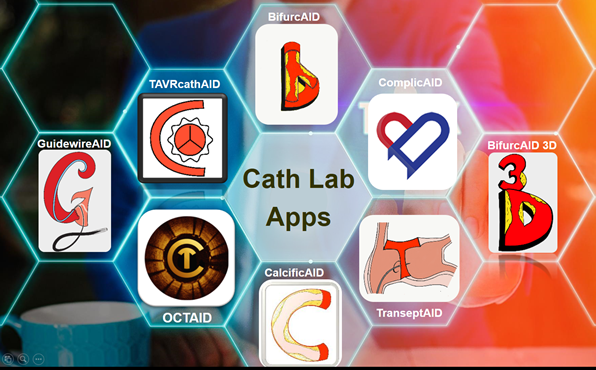Innovative Educational Toolbox For Interventional Cardiology

For more than two decades, the cardiac catheterization laboratory at the Mount Sinai Hospital in New York has been pursuing and developing the latest technical and technological advances in percutaneous coronary intervention (PCI) and structural heart disease treatment. In addition to the relentless drive for procedural excellence, the cath lab is dedicated to teaching and continuous education of fellows in training (FIT) and practicing interventional cardiologists. Our monthly live webcasts of complex coronary, peripheral and structural heart cases have been broadcasting the treatment of complex cases in real time for more than a decade (1). Recently, we decided to move to the next level of digital education and started developing free educational mobile and web applications for cardiologists, fellows, medical students and technicians (2). The six applications currently available at the App Store and Google Play have accumulated more than 36,000 downloads on both Android and iOS platforms across the world (Figure 1).
Health care mobile apps have revolutionized the way we treat our patients. Access to the internet and proliferation of mobile services have transformed the world of medical education. The ACC has emphasized the importance of developing new digital educational platforms for lifelong learning and maintaining competency in clinical practice in the era of rapid technological developments, increasing patient volume and complexity, escalating financial pressure and physician burnout (3). While modern techniques of PCI and troubleshooting tools can be found in multiple publications and textbooks, they are not readily available at the fingertips of an operator at any time. We have attempted to address some of the unique challenges in training future interventional cardiologists by creating a suite of mobile applications for the most challenging areas including the treatment of bifurcation and calcified lesions, PCI after transcatheter aortic valve replacement (TAVR), using optical coherence tomography (OCT) for PCI optimization, performing transseptal puncture and managing procedural complications. The apps' state-of-the art interactive educational content has been created by the experts in the field, is supported by real-world cases and freely available for everyone.

Figure 1. A suite of educational mobile applications for interventional cardiology developed at Mount Sinai catheterization laboratory.
The first app, BifurcAID, was designed as a digital tool to simplify the complex subject of coronary artery bifurcation intervention by providing an illustrated guidance on each step of one of the most challenging interventional procedures. First, the app asks users to choose which process they want to explore, left main or non-left main bifurcation, and then guides them through decision support for the procedure, based on multiple factors including vessel size, lesion morphology and location, and immediate procedural outcomes. We described all steps of the app development from conceptualization to the launch and maintenance, several barriers encountered during the app development and reported survey based data on the app learnability and usability in the first BifurcAID publication (4). In the following report, we summarized the procedural complexities of treating bifurcation lesions and described general considerations regarding the use of a provisional strategy vs. a dedicated two-stent approach (5). Each technique is described in a step-by-step manner using BifurcAID's illustrations and materials. Based on the users' feedback, we developed an animated version of BifurcAID, BifurcAID 3D. The new app incorporates three-dimensional animated models of left main and non-left main bifurcation lesions with all Medina classification variations. Despite the complexity, the user experiences a polished animation accompanied by a detailed description of each step tailored to the lesion selection and immediate procedural outcomes. BifurcAID 3D offers an additional view from within the side branch for each step of PCI, a valuable insight into the procedural details not visible on a traditional angiography. BifurcAID 3D will be released as a mobile application and a website on the CardiologyApps.com in March (2).
The aim of our second educational application, OCTAID, was to teach medical professionals how to perform intracoronary optical coherence tomography (OCT), interpret high-resolution OCT images of the vessel wall, select the best treatment strategy before PCI and optimize post-PCI results. OCT is an emerging intravascular imaging modality, which allows to visualize lesion morphology in vivo with unprecedented detail and clarity comparable to histology. While many research groups including ours have published numerous studies on the use of OCT in clinical trials and studies, OCT image interpretation remains a challenge in many cardiac catheterization laboratories, partially due to the lack of comprehensive interactive teaching tools (6, 7). OCTAID utilizes more than 200 annotated high-resolution images and videos to guide the user through image interpretation and artifacts identification. In addition, the app describes basic equipment, step-by-step instructions for OCT image acquisition and the role of OCT in stent optimization. We update OCTAID's section on "OCT Display" as soon as new features are introduced by the OCT software developers. The Case Review section has been growing to include more complex OCT guided procedures in different settings and currently comprises 16 cases. An interactive portal of the app allows the users to test their knowledge of the material via quizzes and submit their own cases through the "Ask the expert" section.
Following the success of BifurcAID and OCTAID, we developed an educational app teaching how to perform transseptal puncture for various procedures, TranseptAID. The app describes the applied anatomy, access closure, complications, devices and techniques such as the MitraClip procedure, left atrial appendage occlusion, transcatheter mitral valve repair, paravalvular or paraprosthetic leak repair, balloon mitral valvulotomy and pulmonary vein isolation. Interactive animations and live recordings are the key components of the app allowing the user to explore each minute detail of transseptal puncture for different procedures. The app uses fluoroscopy and echocardiography images combined with medical illustrations to better describe different techniques and help the user navigate through challenging scenarios.
Coronary angiography and PCI in patients after TAVR can be challenging due to anatomic relation of the coronary ostia and the prosthetic aortic valve. In the state-of-the-art review, we summarized the factors affecting coronary re-access after TAVR and provided a practical guide on how to manage these complex situations (8). The study's algorithmic approach to coronary angiography and PCI post-TAVR created a foundation for the development of our next educational mobile application, TAVRcathAID. TAVRcathAID educates interventional cardiologists on the increasingly common and frequently challenging arterial access after TAVR. For both of the most common valves in the U.S., TAVRcathAID describes in detail their construction, necessary tools, and difficulties with anatomy and access through the frame. The app's animations help users visualize each step of angiography and PCI after TAVR with self-expanding and balloon-expanding valves.

Despite noticeable advances in treatment approaches, calcified and undilatable lesions continue to present a challenge to interventional cardiologists during lesion preparation and stent placement. Our cath lab is one of the highest volume tertiary referral centers for such highly complex coronary lesions and an active research center exploring new approaches to their treatment (9, 10). The next addition to our suite of interventional cardiology educational mobile apps, CalcificAID, was developed based on our extensive experience and best practices in the field with an objective of helping FIT and interventional cardiologists understand the best ways to treat calcified lesions. CalcificAID guides the user through coronary calcium detection using angiography or intravascular imaging (OCT or IVUS) and treating the lesion with rotational, orbital, or laser atherectomy, atherotomy, or intravascular brachytherapy before stenting. In addition to expert recommendations, the application describes the associated equipment and guides the user through qualitative interpretation and quantitative analysis of calcified lesions.
An educational WebApp ComplicAID is the latest addition to our suite of cardiology apps. The app focuses on recognition and management of complications during PCI with the goal of improving patient safety and outcomes. Procedural complications in our institution for the past 15 years had been thoroughly reviewed to uncover the best teaching cases presenting common as well as rare complications posing significant challenges. Fifty-five total cases were selected for the app with more than 800 angiograms describing every detail of the procedures. Patient history and imaging findings were included in each case to provide a more comprehensive experience. After expert discussion and literature review, a systematic algorithm detailing how to manage and prevent complications was added. The cases involve dissections, perforations, and atherectomy as well as less common complications such as longitudinal stent deformation, vasospasm and air embolism. Many complications, particularly rare ones, may not come up during training or early career. Each case is thoroughly explained followed by a discussion with a toggle feature between the clinical and educational content on relevant published guidelines.
Since the release of BifurcAID in 2017, we remain dedicated to increasing access to high-quality, free education for interventional cardiologists around the world. We continue to expand our suite of educational mobile and web applications by adopting innovative teaching approaches via smartphone technologies to offer interactive and realistic learning environment for FIT and early carrier interventional cardiologists. Our goal is to create a suite of mobile and web applications covering nearly every aspect of interventional cardiology. Several new apps are currently under development. One of them is GuidewireAID, an application that describes the design of coronary guidewires and how their design influences their clinical use. Over two dozen teaching cases and a wire library with more than a hundred wires provide tailored learning opportunities and unique user experience. For updates on our mobile application efforts, we have created a website, www.cardiologyapps.com, where all the apps can be explored.
In addition to innovating medical education, we are committed to developing digital solutions to improve patient experience and satisfaction. The aim of one of our ongoing projects is to create a digital platform, TAVRbot, to optimize the experience of patients undergoing TAVR. Traditional care models that prepare patients for the procedure are labor and resource intensive, and might lead to procedural cancellation, poor patient satisfaction and loss of revenue. TAVRbot will offer the patients easily accessible, personalized information regarding their pre-procedural tests, the procedure itself, post-TAVR care and follow-ups. Patients will receive notifications regarding their procedure and workup time and locations. Responding to these automated messages will give them an option to ask a trained chatbot or contact our nurses through a convenient portal of their phones.
References:
- CCCLive cases https://ccclivecases.org
- CardiologyApps.com https://cardiologyapps.com/
- A New Educational Framework to Improve Lifelong Learning for Cardiologists. Narang A, Velagapudi P, Rajagopalan B, LeBude B, Kithcart AP, Snipelisky D, Sinha SS. J Am Coll Cardiol 2018 Jan 30;71(4):454-462.
- Developing a Mobile Application for Global Cardiovascular Education. Bhatheja S, Fuster V, Chamaria S, Kakkar S, Zlatopolsky R, Rogers J, Otobo E, Atreja A, Sharma SK, Kini AS.. J Am Coll Cardiol. 2018 Nov 13;72(20):2518-2527.
- Treatment strategies for coronary bifurcation lesions made easy in the current era by introduction of the BIFURCAID app. Selan JC, Yoshimura T, Bhatheja S, Sharma SK, Kini AS. Future Cardiol. 2019 Jan;15(1):39-52
- Kini A, Narula J, Vengrenyuk Y, Sharma S. Atlas of Coronary Intravascular Optical Coherence Tomography. Springer 2017.
- Kini AS, Vengrenyuk Y, Shameer K, Maehara A, Purushothaman M, Yoshimura T, Matsumura M, Aquino M, Haider N, Johnson KW, Readhead B, Kidd BA, Feig JE, Krishnan P, Sweeny J, Milind M, Moreno P, Mehran R, Kovacic JC, Baber U, Dudley JT, Narula J, Sharma S. Intracoronary Imaging, Cholesterol Efflux, and Transcriptomes After Intensive Statin Treatment: The YELLOW II Study. J Am Coll Cardiol. 2017 Feb 14;69(6):628-640
- Coronary Angiography and Percutaneous Coronary Intervention After Transcatheter Aortic Valve Replacement. Yudi MB, Sharma SK, Tang GH, Kini A. J Am Coll Cardiol 2018 Mar 27;71(12):1360-1378.
- Kini AS, Okamoto N, Barman N, Vengrenyuk Y, Yasumura K, Chamaria S, Bhatheja S, Kapur V, Hasan C, Sweeny J, Baber U, Mehran R, Stone GW, Sharma S. Side branch fractional flow reserve after provisional stenting of calcified bifurcation lesions: The ORBID-FFR study. Catheter Cardiovasc Interv. 2020 Oct 9. doi: 10.1002/ccd.29307. Online ahead of print.
- Procedural and one-year outcomes of patients treated with orbital and rotational atherectomy with mechanistic insights from optical coherence tomography. Okamoto N, Ueda H, Bhatheja S, Vengrenyuk Y, Aquino M, Rabiei S, Barman N, Kapur V, Hasan C, Mehran R, Baber U, Kini AS, Sharma SK. EuroIntervention. 2019 Apr 20;14(17):1760-1767.
This content was developed by Annapoorna Kini, MD, MRCP, FACC, independently from the content developed for ACC.org. This content was not reviewed by the American College of Cardiology (ACC) for medical accuracy. Inclusion on ACC.org does not constitute a guarantee or endorsement by the ACC, nor do statements or opinions expressed represent official ACC opinions or policies.

